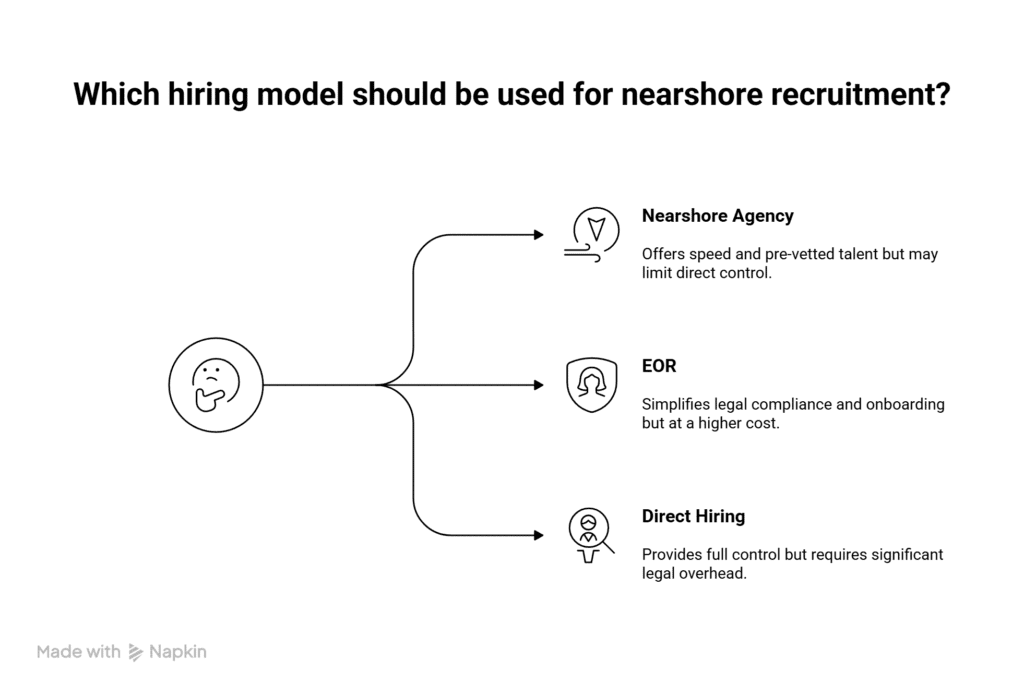Hiring talent in Latin America (LATAM) offers businesses access to skilled professionals across diverse industries. With competitive costs, a growing pool of bilingual candidates, and time zone alignment with the US, LATAM has become a strategic choice for companies looking to expand their teams efficiently. Understanding the hiring process in this region is key to building successful partnerships.
From labor laws and cultural aligment to sourcing top talent, recruiting in LATAM requires careful planning. Each country has unique regulations and practices that can impact your approach. Knowing where to find qualified candidates and how to navigate these differences ensures you attract the right fit for your business needs.
Are you ready to explore how LATAM can help scale your workforce while maintaining quality?
Let’s jump into the essential steps and insights you need to hire effectively in this thriving market.
How to Hire LATAM Talent Through a Nearshore Staffing Partner
Hiring nearshore professionals in Latin America offers US businesses access to skilled talent, cost savings, and time zone alignment. A nearshore staffing partner simplifies the process by managing recruitment complexities and ensuring compliance.
#1 Define Role Scope, Headcount Needs, and Time Zone Alignment
Clarify the job responsibilities, required skills, and team size before engaging with a nearshore staffing partner. Specify whether you’re hiring for technical roles like engineering teams or support functions such as marketing job titles. Ensure candidates align with your working hours if you’re building a remote team in your time zone. This step prevents mismatched expectations during the hiring process.
#2 Select a Nearshore Staffing Agency With Regional Domain Expertise
Choose a nearshore agency experienced in cross-border recruiting within LATAM countries. Verify their knowledge of labor laws, payroll systems, and compliant hiring in Latin America. Ask questions about their success placing C1 English level professionals or C2 English talent for US timezone remote teams. Agencies with proven expertise streamline operations while reducing legal risks.
#3 Align on Talent Profile, Interview Structure, and SLA Expectations
Collaborate with your staffing partner to define candidate profiles based on technical skills, language proficiency, and cultural fit. Agree on interview stages tailored to specific roles like sales managers hires or nearshore tech talent for US firms.
Establish service-level agreements (SLAs) covering timelines for sourcing candidates and response times for queries.
#4 Tap Into Pre-Built Talent Pools by Function and Country
Leverage pre-vetted databases maintained by nearshore recruitment agencies to speed up hiring cycles. These pools often include specialists across industries—such as software developers from Brazil or bilingual sales development representatives from Mexico—allowing quick access to qualified candidates without starting searches from scratch.
#5 Co-Manage Interviewing, Vetting, and Offer Rollout
Work closely with your staffing partner during interviews to assess both hard skills and soft skills relevant to long-term nearshore hires.
Use structured vetting processes that evaluate problem-solving abilities for dev teams or communication capabilities for marketing hires. Let the agency handle offer letters while ensuring competitive salary benchmarks in LATAM markets are met.
#6 Handle Contracts and Onboarding Through Agency or EOR Model
Rely on the agency’s Employer of Record (EOR) services when hiring full-time employees outside the US without setting up foreign entities yourself. The EOR model ensures contract compliance under local regulations while simplifying payroll management for remote workforce in Latin America.
Streamline onboarding processes through tools provided by the agency to integrate new hires effectively into your team.
#7 Set KPIs, Feedback Loops, and Retention Milestones
Define performance metrics tied directly to business goals when scaling teams with nearshore professionals. Regular feedback loops improve engagement among distributed teams while addressing potential frustrations early on.
Plan retention strategies such as offering growth opportunities or aligning benefits packages competitively to retain remote employees in LATAM over the long term.

Choosing the Right Country for Each Function
Building an effective nearshore team starts with understanding where each type of professional talent thrives across Latin America. Different countries have developed distinct strengths in sales, marketing, and engineering, shaped by education systems, business cultures, and time zone compatibility with the U.S.
Working with experienced nearshore staffing agencies ensures that your hiring strategy leverages these regional advantages while maintaining compliance and cost efficiency.
Sales Recruitment Across Latin America
For sales and customer-facing roles, Mexico, Colombia, Chile, and Costa Rica offer some of the most reliable talent pools for U.S. businesses.
Mexico provides one of the largest concentrations of bilingual sales professionals with proven experience in outbound prospecting, lead qualification, and CRM systems like HubSpot, Salesforce, and Outreach. Its proximity to the U.S. supports same-day communication and shared working hours—key for sales development representatives (SDRs) and account executives managing U.S. territories.
Colombia has become a strong hub for inside sales and business development. Professionals from Bogotá, Medellín, and Cali combine C1-level English proficiency with familiarity in SaaS and B2B lead-generation environments.
Chile’s well-developed business infrastructure attracts sales specialists with strong negotiation skills and financial literacy—qualities that make them effective for enterprise sales or regional account management.
Costa Rica complements these markets with an educated workforce trained in customer experience and client retention, supported by stable internet infrastructure and a business culture aligned with U.S. standards.
Together, these markets give U.S. firms access to bilingual, performance-driven professionals capable of managing remote sales operations and maintaining pipeline visibility across multiple time zones.
Marketing Recruitment Across Latin America
Marketing expertise is spread across several key countries, each offering unique strengths that support global campaign execution.
Argentina is widely known for creative and content marketing talent. Professionals here often have agency experience and combine storytelling skills with technical abilities in SEO, paid media, and analytics platforms such as Google Ads, SEMrush, and Meta Ads Manager.
Their ability to adapt U.S. messaging for international markets makes them valuable for brand localization.
Colombia and Mexico excel in digital marketing and campaign execution. Marketing coordinators in these regions have practical experience managing advertising budgets, optimizing performance metrics, and producing bilingual content that connects with both U.S. and Latin American audiences.
Peru and Ecuador are becoming cost-efficient sources for graphic design, video editing, and social media management. These markets are ideal for businesses looking to scale creative output quickly while maintaining quality standards.
Uruguay and Costa Rica also contribute top-tier talent in brand management and content strategy, offering smaller but stable teams well-versed in English communication and remote collaboration tools.
Partnering with a marketing recruitment agency in Latin America helps businesses match campaign requirements with the right regional expertise, reducing time-to-hire while improving cultural alignment and ROI.
Engineering and Technical Recruitment Across Latin America
For engineering and software development, Brazil, Argentina, Mexico, and Peru are the strongest sources of full-stack and data-focused professionals.
Brazil leads in volume, producing thousands of software developers and data engineers annually. Its professionals are skilled in modern frameworks like React, Python, Java, and Node.js, making it a natural choice for U.S. companies scaling technical teams offshore.
Argentina continues to deliver consistent quality in backend and full-stack engineering. Developers from Buenos Aires and Córdoba are fluent in agile workflows and often work with global startups.
Mexico offers a mix of senior software engineers and IT specialists experienced in cloud computing, cybersecurity, and DevOps—a valuable asset for companies managing distributed infrastructure.
Peru and Chile are growing as regional tech hubs, supported by strong STEM programs and private investment in digital skills. Developers here tend to be reliable for long-term contracts and enterprise systems maintenance.
Paraguay and Guatemala are smaller markets but emerging fast in QA testing, automation, and support engineering, offering lower-cost alternatives for companies looking to diversify their nearshore workforce.
Across these countries, nearshore engineering recruitment enables faster onboarding, lower payroll costs, and consistent overlap with U.S. time zones—making collaboration easier than with offshore teams in Asia or the Philippines.
Comparing Hiring Models: Agency vs Direct vs EOR

Nearshore Agency: Speed, Pre-Vetting, Regional Compliance
Using a nearshore recruitment agency accelerates the hiring process by leveraging pre-vetted talent pools. These agencies specialize in sourcing candidates with C1/C2 English proficiency and aligning them with US timezone remote teams. They handle regional compliance, ensuring contracts and payroll for LATAM talent meet local labor laws. This approach reduces administrative burdens while maintaining access to skilled professionals across Latin America.
Agencies also offer flexibility through scalable staffing solutions, making it easier to adjust headcount based on project needs. For example, marketing roles nearshore can be filled quickly due to their established networks of creative professionals in Argentina or Colombia.
But, relying on an agency may limit direct control over candidate selection and team integration.
EOR: Legally Employ Without Entity Setup
An Employer of Record (EOR) allows you to hire full-time employees outside the US without establishing a legal entity in LATAM countries. The EOR becomes the official employer, managing compliant hiring in Latin America by handling taxes, benefits, and employment contracts under local regulations. This model simplifies onboarding nearshore employees while mitigating risks tied to cross-border recruiting.
For long-term remote staffing, using an EOR ensures operational efficiency when scaling teams with nearshore professionals. It’s particularly effective for engineering teams nearshore that require seamless integration into your existing workflows.
While this model offers convenience and legal coverage, it comes at a higher cost compared to direct hiring or agency models.
Direct Hiring: Full Control, Higher Legal Overhead
Direct hiring provides complete control over the recruitment process but requires understanding of complex labor laws specific to each LATAM country. You oversee every aspect of building a distributed team—from sourcing candidates for technical hiring in Latin America to managing contracts and payroll LATAM talent directly.
This model is ideal if you’re focused on retaining remote employees in LATAM for long-term growth since you build stronger relationships with hires from day one. But, setting up compliant operations involves significant time investment and financial resources.
For instance, recruiting in Mexico or Brazil might demand understanding tax structures and worker protections unique to those regions.
Compliance, Payroll, and Labor Law Insights
Understanding compliance, payroll systems, and labor laws is essential when hiring nearshore professionals in Latin America. Each country has unique regulations that impact employment contracts, tax obligations, and termination processes.
Key Employment Regulations in Top LATAM Markets
Employment regulations vary significantly across LATAM countries. In Brazil, employees are entitled to a 13th-month salary and mandatory vacation pay. Mexico requires profit-sharing payments (10% of taxable income) for full-time employees. Argentina enforces strict severance rules based on tenure and salary.
Non-compliance with local labor laws can lead to penalties or legal disputes.
Partnering with a nearshore recruitment agency simplifies adherence by ensuring compliant hiring in Latin America.
Local Payroll Systems vs Agency-Managed Infrastructure
Managing payroll directly involves understanding local tax codes, currency exchange rates, and reporting requirements. For example, Colombia mandates monthly contributions to health insurance and pension funds from both employers and employees.
Agency-managed infrastructure offers streamlined solutions for contract and payroll LATAM talent management. These agencies handle tax filings, deductions, and cross-border payments efficiently—ideal for US businesses scaling teams without establishing foreign entities.
IP Protection, NDAs, and Termination Complexity
Protecting intellectual property (IP) during remote team onboarding in LATAM is critical for safeguarding business assets. Draft robust non-disclosure agreements (NDAs) tailored to each country’s jurisdiction to prevent data breaches or unauthorized use of proprietary information.
Termination complexity varies; Peru mandates compensation based on unjust dismissal claims while Chile applies stricter notice periods for layoffs. Collaborating with an Employer of Record ensures compliance with termination laws while reducing risks tied to wrongful dismissals or misclassified workers.
Structuring Offers to Attract and Retain LATAM Talent
Crafting competitive offers is essential for hiring nearshore professionals in Latin America. A well-structured offer aligns with local expectations, ensures compliance, and supports long-term retention.
Role-Based Salary Benchmarks Across LATAM
Salary benchmarks vary significantly across LATAM countries based on roles and market conditions. For example, software engineers in Brazil earn $25,000–$50,000 annually, while similar roles in Argentina range from $20,000–$40,000. Marketing specialists in Colombia typically command $18,000–$35,000 per year. Sales members in Mexico often receive $15,000–$30,000 annually due to their bilingual skills and proximity to the US timezone.
Research salary data specific to each country before extending offers. Collaborate with a nearshore recruitment agency or staffing partner to access up-to-date compensation insights. Offering competitive pay within these ranges helps attract top-tier talent without exceeding budget constraints.
Common Benefits Expectations by Country
Benefits packages influence how candidates perceive your offer. In Mexico, employees expect health insurance coverage and profit-sharing bonuses (10% of company profits). Brazilian workers prioritize meal vouchers and transportation allowances alongside mandatory 13th-month salaries. Colombian professionals value private healthcare plans and performance-based incentives.
Customize benefits according to local norms using input from nearshore workforce management experts. Including region-specific perks demonstrates cultural awareness and enhances appeal among potential hires.
Retention Tactics: Remote Culture, Progression, Flexibility
Retention hinges on fostering engagement through remote-first strategies. Build a strong remote culture by organizing virtual team-building activities that connect US teams with LATAM hires. Offer clear career progression paths tailored to individual goals; for instance, provide leadership training for high-performing engineering teams nearshore or advanced certifications for marketing roles nearshore.
Flexibility also matters—allow flexible schedules accommodating regional time differences when managing teams across US and LATAM locations. These tactics reduce turnover risks while ensuring alignment between business objectives and employee satisfaction levels.
The Right Partner Makes LATAM Hiring Repeatable and Scalable
Successfully hiring in LATAM requires a strategic approach, regional expertise, and compliance with local regulations. By leveraging the right nearshore staffing partner or Employer of Record, you can streamline recruitment, mitigate risks, and focus on building high-performing teams. With tailored strategies for sourcing talent, managing payroll, and fostering retention, you’ll position your business to thrive in this dynamic market.
Partnering with experts ensures that every step—from identifying top candidates to navigating labor laws—is handled efficiently. This not only accelerates your hiring process but also sets the foundation for long-term success as you scale your workforce across Latin America.
Hire Top LATAM Talent and Build Strong Remote Teams
Book a Strategic CallFrequently Asked Questions
Why should companies hire talent from Latin America (LATAM)?
Hiring talent from LATAM offers access to skilled professionals, competitive costs, a growing pool of bilingual candidates, and time zone alignment with the US. These factors make it an attractive region for building remote teams while ensuring effective collaboration.
What are the key steps to hiring in LATAM?
Key steps include defining role requirements, partnering with a nearshore staffing agency, aligning on candidate profiles, co-managing interviews, using an Employer of Record (EOR) for compliance, and setting KPIs and retention strategies.
What is an Employer of Record (EOR), and how does it help?
An EOR allows companies to hire full-time employees without establishing a legal entity in LATAM. It handles contracts, payroll compliance, onboarding processes, and local labor law adherence.
How do nearshore staffing agencies streamline hiring in LATAM?
Nearshore agencies provide pre-vetted talent pools, manage regional compliance issues like labor laws and taxes, and accelerate the recruitment process by leveraging their local expertise.
What are common employment regulations in LATAM countries?
Regulations vary by country. For example:
- Brazil requires a 13th-month salary.
- Mexico mandates profit-sharing payments.
Non-compliance can lead to penalties; working with experts ensures adherence to these rules.
How can intellectual property (IP) be protected when hiring remotely in LATAM?
Protect IP by implementing robust non-disclosure agreements (NDAs) tailored to each country’s jurisdiction during onboarding. Collaborating with legal experts or EORs helps ensure compliance.
Should companies handle payroll directly or use agency-managed systems?
Using agency-managed payroll simplifies tax reporting and compliance with local regulations. Direct management provides control but requires navigating complex tax codes independently.
How can businesses structure competitive offers for LATAM talent?
Align offers with local market expectations using role-based salary benchmarks and tailored benefits packages such as healthcare or flexible schedules to attract top-tier candidates.
What retention strategies work best for remote teams in LATAM?
Retention strategies include fostering strong remote culture through regular communication, offering career growth opportunities, providing flexibility in work hours aligned with regional needs, and recognizing employee contributions regularly.




